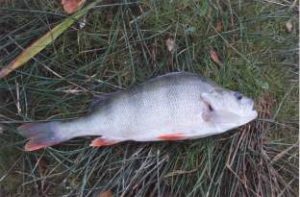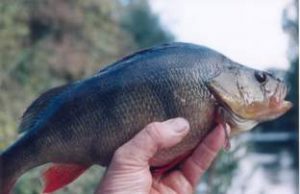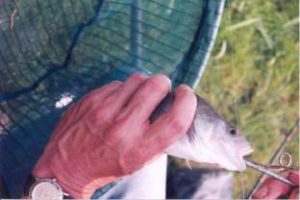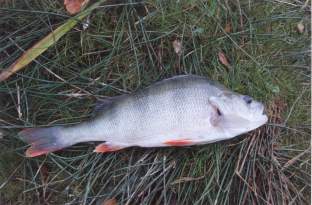Let me start by saying that summer is not the best time to catch perch in numbers – at least not in my waters. This is because perch are scattered about at this time of year rather than shoaled up as in the colder months. However, this does mean that we can usefully employ roving tactics to find our quarry. For many anglers this will make a pleasant change from sitting behind buzzers waiting for a carp or tench to bite, or working up a swim to catch a net-full of smaller fish. Occasionally, this “trapping” approach will snare a good perch, but for real success in the summer the “hunter” will invariably be more successful.
 As always, the first step is location. The best way to discover good perch waters is to ask around; because perch are not the “in fish” other anglers are usually very willing to share their knowledge. The size of the water is immaterial and good perch have come from a wide variety of habitats including the smallest of ponds and streams. However, the type of water will invariably dictate the best tactics to adopt.
As always, the first step is location. The best way to discover good perch waters is to ask around; because perch are not the “in fish” other anglers are usually very willing to share their knowledge. The size of the water is immaterial and good perch have come from a wide variety of habitats including the smallest of ponds and streams. However, the type of water will invariably dictate the best tactics to adopt.
To get away from the crowds try searching out a small river or stream, which will often be deserted in the summer. It may appear unfishable because of head-high bank-side vegetation and dense beds of lilies and bulrushes. However, don’t let this put you off as in fact such waters are very easy to fish. All you have to do is avoid scaring the fish, and then put a bait in front of them!
This means that you should keep off the skyline, wear drab clothing and ensure that you make as few vibrations as possible. Banging rod rests in the ground is definitely out! Just because you can’t see the fish, don’t expect that any but the smallest won’t be scared by such actions. If you imagine that you’re creeping up on a bird you won’t go far wrong.
The best swims to try are those where the light is dim as perch feed best in these conditions, when their poorer-sighted prey are then at a disadvantage. For this reason, dull days are much to be preferred and if you can fish at dusk, or better still dawn, so much the better. Undercut banks especially around tree roots are particularly flavoured, provided that the current is sluggish. Such swims with a faster current will probably hold chub. Other likely areas are bridges, and bulrush beds. Bulrushes are the tall round-stemmed reeds that look like green fishing rods. They grow only on a firm bottom such as gravel or clay, which perch definitely seem to prefer. Unlike chub, which can sometimes be enticed out of such cover, the bigger perch tend to remain close to their sanctuary. To avoid getting snagged use a swan shot link leger, and if you want to add a float to fish above the bottom, attach it to the line at both ends with long pieces of valve rubber.
If you put the shot directly under the float and cast underarm tight to the cover, you should find that the lighter bait follows the float and doesn’t swing away from where the fish are holed up.
Turning to baits, maggots in weedy water are a poor bet as you need heavy tackle which in turn means that small baits won’t behave naturally. Instead, my two favourites for this method are lobworms and small freshwater deadbaits. (For some reason sea deadbaits are not much use). To make worms more weedless, hook the bait normally but then twist the hook through 180 degrees and insert it back into the bait so that the point of the hook is covered. If you do this, you’ll need to strike a bit harder than normal.
Tackle for this style of fishing should be kept to a minimum as you should spend perhaps half an hour to an hour in each swim until you find some fish. Almost any float or leger rod will do, as will a light carp rod, provided it has some give in the tip, as a stiff rod will often pull the hook out of the soft mouth of a perch. Generally I use 61b main line for perching on overgrown rivers with a lighter 41b hook length of either nylon or Silkworm braid. This is matched to hooks ranging from size 4 to size 12 depending on the size of the bait.
 I hope you’ll now see that fishing small weedy rivers is in fact easy. You could also surprise yourself with the size of some of the fish you catch!
I hope you’ll now see that fishing small weedy rivers is in fact easy. You could also surprise yourself with the size of some of the fish you catch!
If, on the other hand, you decide to fish a larger water, I’d recommend that you try spinning, as this will also enable you to seek out the scattered perch simply by covering a lot of water.
Choice of venue for spinning is very important. Firstly, it’s no point trying a crowded water, and secondly, not all fisheries respond to spinning. Generally, the clearer the water the better your chances, whilst coloured carp lakes are often a waste of time.
Most venues also contain pike and on these it is vital to use heavier tackle and, most importantly, a wire trace. Failure to do so could cost you your lure, what’s worse any pike you hook, its life! I cannot stress this highly enough.
If pike are present, 81b line is the absolute minimum even for the experienced. In turn this means that you won’t be able to cast the small lures often recommended for perch very far. Don’t let this worry your though as nine times out of ten, bigger lures are better anyway! For bank fishing for perch, I tend to use lures from 7 to 28 grams.(1/4 to loz) which may be anything from 5 to lOcms long (2 to 4 ins.) When you look carefully at the size of a perch’s’ open mouth you’ll realize that this in none too big. I once kept a 25cm (10″) perch in my aquarium that had no trouble swallowing a l3cm (5″) gudgeon.
 As far as rods are concerned, my choice would be a quivertip rod. This shows up subtle takes very well and you’ll be surprised just how many of these normally go unnoticed. Perch in particular often strike repeatedly at the tail of their quarry and a quiver tip gives you early warning of a proper pull.
As far as rods are concerned, my choice would be a quivertip rod. This shows up subtle takes very well and you’ll be surprised just how many of these normally go unnoticed. Perch in particular often strike repeatedly at the tail of their quarry and a quiver tip gives you early warning of a proper pull.
The range of lures is boundless but few UK tackle shops stock very many. However ABU lures aren’t too hard to find and are very effective. The models to look for especially are the Reflex spinners and Atom spoons. In general look for natural colours on lures except in dirty water when flourescent finishes are usually more effective. If you become keen on spinning you’ll need to contact the specialist mail order firms such as Harris Angling of Norfolk and the Friendly Fisherman..
Most anglers, whether after perch or pike, fish lures too fast and too high in the water. Perch are not very quick off the mark and so a fast retrieve may not be effective if the fish aren’t very hungry. This is especially so in cold weather when it is almost impossible to retrieve too slowly.
On some days you’ll need to retrieve steadily, on others erratically. However, often better that either is to fish “sink and draw”. This is done by raising the rod top without reeling in, and then gradually lowering the rod and at the same time starting the retrieve. The speed of retrieve should be such that the lure just flutters down on slightly slack line. Takes are most likely as the lure sinks and so carefully watch the line (I prefer a flourescent one) for touches.
Turning to depth, floating plugs will dive to a set maximum depth depending on their design. They are thus very useful for fishing just above sub-surface weedbeds. Sinking lures, whatever the type, are best fished by the “countdown” method. With this you cast out and then close the bail arm to allow the lure to sink on a tight line, whilst counting or singing to yourself. When the line goes slack it will either be a take “on the drop”, or the lure will have reached the bottom. If no takes are forthcoming start the retrieve, then on the next cast count to a smaller number and try at that depth, and so on up to the surface. Alternatively if the swim is snaggy start shallow and gradually work deeper, which should mean less lost lures.
However, you will almost invariably catch more if you’re prepared to fish near the snags or sudden changes of depth as that is where the bigger perch in particular usually are. Granted this could cost you a few lures but at least it won’t cost you fish. In any event, lures work out at little more than a pint of maggots or a packet of boilies, and by gradually buying a selection, you’ll also have the tremendous fun of building up a lure collection!
Shortage of time means I’ve been able to only scratch the surface about summer perch. Further details can be found in “The Book of the Perch” by the Perchfishers, which can be obtained direct from the club.
Thanks to Roger Standen of the Freshwater Informer for the use of these photographs.













